One of the most popular cuisines in the world is Korean. In a study of the top international dishes on Instagram, it came in fourth place.
Korean offer something that foodies have begun craving for: an experience. It’s not only about the food you’re fed: the experience itself is just as important. And perhaps the huge success of the film Parasite helped turned the world’s attention to South Korea and everything it has to offer.
The four distinct seasons of Korea mean a variety of seasonal foods using local ingredients at their best in spring, fall, and winter.In spring, Koreans enjoy seasonal spring greens not seen throughout the long winter. In the hot summer, they cool down with cold food or replenish their energy with high protein ingredients. During the harvest season, there is a great variety of foods and in the cold winter, high nutrition fermented foods are enjoyed and prepared for long storage.Along with the increasing popularity of Korean culture, such as K-drama and K-Pop, Korean food is also enjoying increased interest. Here are 25 Korean dishes that are loved by both Koreans and foreigners alike.
Rice-based Korean Food
The optimal conditions for rice farming in Korea mean a wide variety of foods based on rice. It is the largest staple food for Koreans and is always served as a companion to main dishes. Of course, there are also several main dishes using rice. The following are a representative sample of how rice is served in Korean cuisine.
1. 비빔밥 (Bibimbap: Mixed Rice with Vegetables)
Bibimbap is a dish of rice and mixed vegetables. You can also add eggs, fried ground pork, or beef depending on choice. The most common seasoning is red pepper paste, but those who don’t enjoy spicy food often use soy sauce.
The origin of bibimbap is not clear, but it is highly likely that it is passed down from offerings to ancestors during ancestral rites.
2. 김밥 (Gimbap: Korean Seaweed Rice Rolls)
Gimbap is a dish made of dried seaweed rolled up with white rice and various ingredients such as spinach, pickled radish, carrot, egg, burdock, etc. and cut it into bite-sized pieces. It is very convenient when traveling or for eating on picnics.Gimbap is named depending on the main filling. Tuna gimbap is canned tuna, mayonnaise, sesame leaves, and other vegetables, for example, and there are many others such as cheese, kimchi, and beef gimbap.
3. 떡국 (Tteokguk: Korean Rice Cake Soup)
Tteokguk is beef broth boiled up with rice cake. It is especially popular on Lunar New Year’s Day, which is one of the biggest holidays in Korea.Tteokguk itself is made by cutting up ‘Garae Tteok’, a long strip of rice cake dough, which represents a long life. But it can also be cut into the round coin-like shapes, which symbolize wealth.By eating rice cake soup during the festival, Koreans celebrate becoming one year older and gaining greater wisdom while wishing for prosperity and longevity.
Korean Noodle Dishes
Noodles are a key feature of Korean gastronomy and over the years, a variety of noodle-based dishes have been developed. The shape of the long noodles represents good luck, wealth, health, happiness, and eternal love. This is what makes them a favorite during celebrations such as birthdays and weddings, bringing good fortune and energy for the future.
Here are some Korean noodle dishes the people love and that are enjoyed the world over.
4. 잡채 (Japchae: Glass Noodle Stir Fry)
In the Korean language, Japchae means ‘noodles mixed with various vegetables’. It is made with sweet potato starch noodles stirred with various fried vegetables such as carrots, spinach, mushrooms, and onions. The dish is then seasoned with soy sauce.Japchae originated from a food made by a civil official as a gift for the king during the Joseon Dynasty. It is said that the king enjoyed the taste of japchae so much that it became his most favorite dish and it is also said to help officials rise to higher-ranking positions.
5. 라면 (Ramyun: Korean Instant Noodles)
Ramyun is commonly regarded as instant noodles. With low prices and simple recipes, it has become one of Koreans’ favorite dishes, often eaten as a snack. In fact, Koreans consume the most ramen per person in the world.
With Korean instant noodles appearing in Korean dramas and movies, they are becoming popular with people around the world as a substitute for other snacks. In the United States, the cheese Ramyun recipe (cheddar cheese on top of ramyun) is becoming popular and in Australia, a well-known chef has even developed a menu using Korean instant noodles.
6. 냉면 (Naengmyeon: Cold Noodles)
Naengmyeon means cold noodles. They are largely divided into two types: Pyeongyang and Hamheung. Each dish has its own unique taste, making them very distinct. Pyeongyang is known as ‘mul’ (water) naengmyeon because it’s served in plain broth, while hamheung is known as ‘bibim’ (mixed) naengmyeon because it is mixed with red pepper paste.The noodles are served with cucumber, pear, and slices of pickled radish, with half a boiled egg on top. White vinegar and mustard can be added for extra zing.
Korean Soups
Soup and rice are often served together in Korean cuisine. While rice is the most important part of a meal, soup comes second followed by side dishes.Korean soups are divided into four main types: Guk (국), Tang (탕), Jjigae (찌개), and Jeongol (전골). Guk is mainly made of broth, tang requires a little longer cooking time than guk, and jjigae has more solid ingredients in it. Jeongol is cooked directly at the table. The following are the most popular soups for both Koreans and non-Koreans.
7. 김치찌개 (Kimchi Jjigae: Kimchi Stew)
Kimchi is a traditional soup that is considered the national food. Thanks to the health benefits, this country’s iconic food is also loved by many people around the world. Admittedly, there are many Kimchi-based foods in Korea. Kimchi jjigae is a stew based on kimchi.There are various kimchi jjigae recipes, but the most common is made with pork, kimchi, and tofu. Kimchi, used for kimchi jjigae, is fermented to a certain extent because the specific flavors are brought out more than when kimchi has just been made.
8. 삼계탕 (Samgyetang: Ginseng Chicken Soup)
Samgyetang is a chicken soup made with a whole chicken and ingredients such as glutinous rice, ginseng, jujube, and garlic. The ‘sam’ in its name, samgyetang, means ginseng, which is essential for this famous chicken soup.Koreans traditionally eat samgyetang during the three hottest days in July and August called ‘Sambok’, to supplement the energy that is lost due to the hot weather.
9. 순두부찌개 (Sundubu Jjigae: Korean Spicy Soft Tofu Stew)
Sundubu jjigae is one of the most popular dishes in Korean restaurants overseas. Sundubu is uncurdled and unpressed tofu.
The classic version of sundubu jjigae is made simply with plain tofu in broth, which is called Chodang tofu. However, sundubu jjigae, with spicy seasoning including red pepper oil and red pepper powder, is much more well-known and popular all over the world.
10. 감자탕 (Gamjatang: Pork Back-Bone Soup)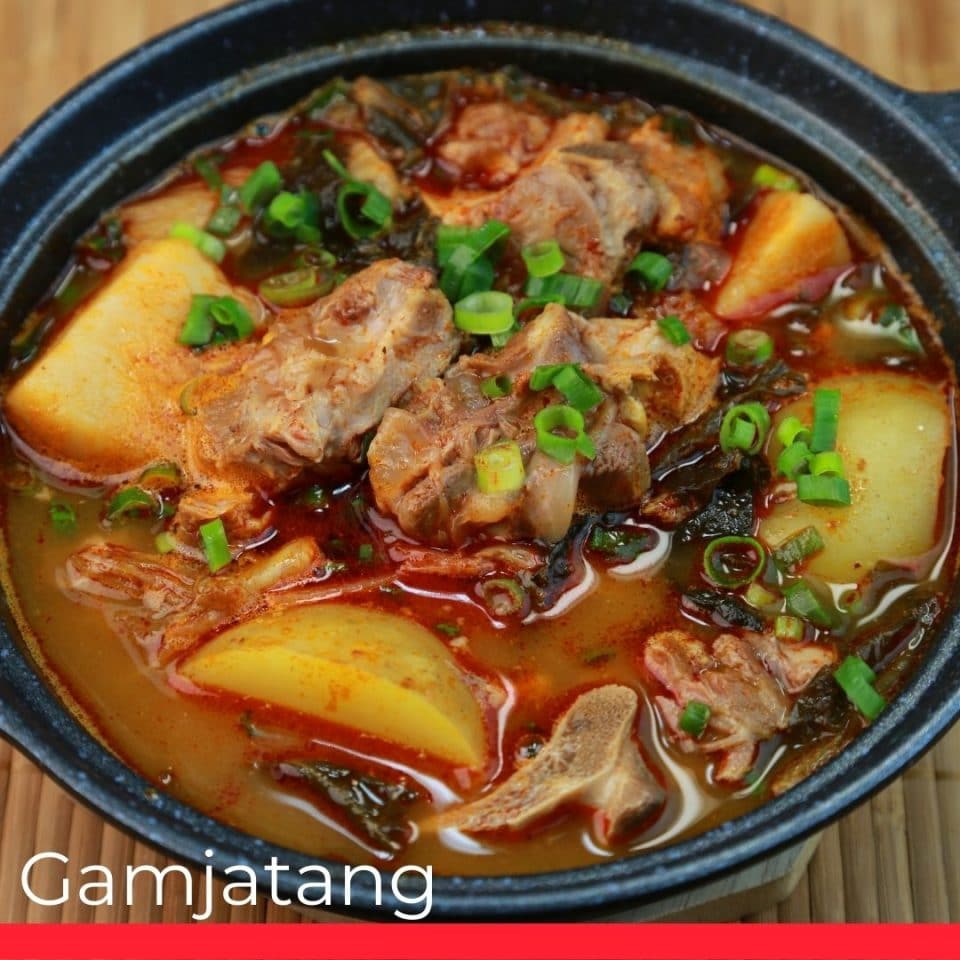
Gamjatang is a soup made using pork backbone. This fascinating and well-loved dish is boiled with potatoes, vegetables, perilla seeds, and so on. The soup is well known as a hangover cure eaten early in the morning, so there are many gamjatang restaurants open 24 hours.
When foreigners who have traveled to Korea are asked to list their ‘favorite Korean foods’, gamjatang most often ranks top.
11. 부대찌개 (Budae Jjigae: Army Stew)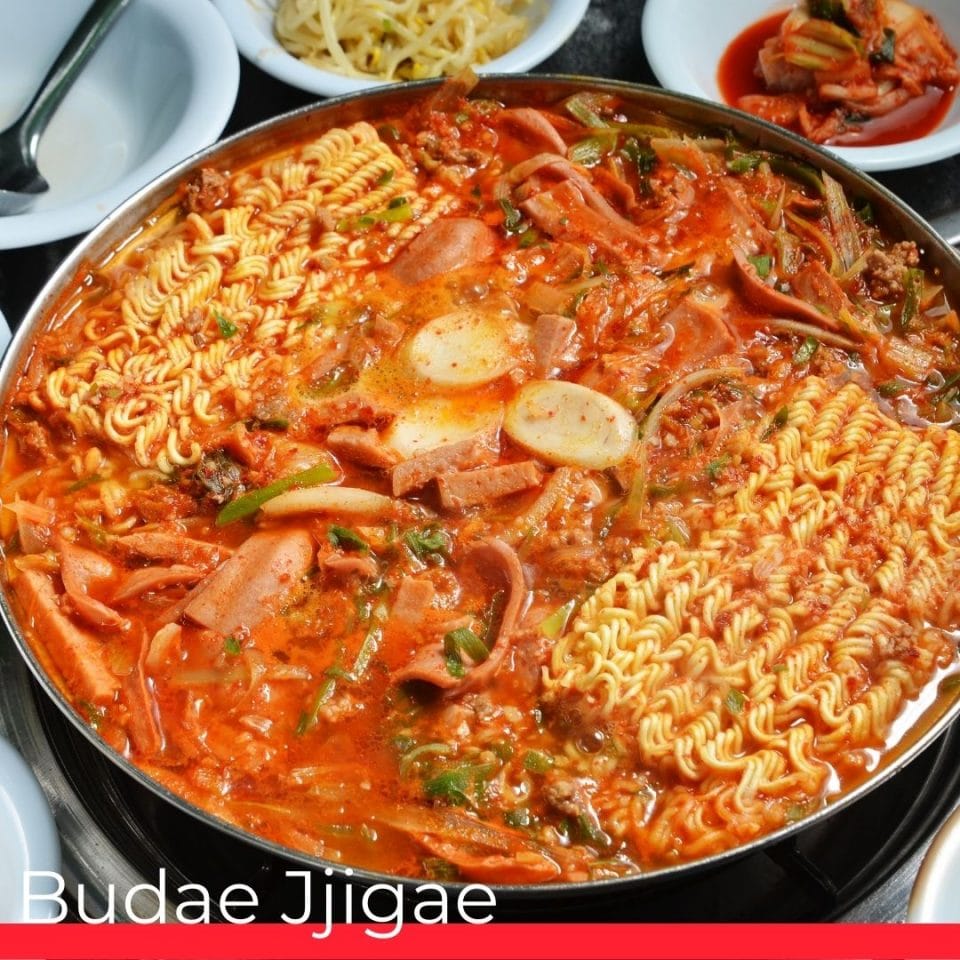
Budae jjigae is the first Eastern and Western fusion dish in Korea. The word ‘Budae’ means military unit.After the Korean War (1950-1952), there was a food shortage. When Koreans came across unfamiliar ingredients such as canned ham and sausage enjoyed at the U.S. military unit in Korea, they began to create recipes to suit their particular taste. They mixed ham and sausage with kimchi and gochujang (red pepper paste), and budae jjigae was created.
Korean Meat Dishes
With the rapid economic development from the 1980s, ordinary Koreans became able to incorporate more meat into their diets. In the past, however, meat dishes were not commonly served except during special occasions such as Seollal (Korean New Year’s Day) or Chuseok (Korean Thanksgiving Day).
In 1970, Korea consumed only 5.2 kilograms of meat per person per year. This began to exceed 10kg in the 1980s, and then 30kg in the 2000s. Since then, many Korean meat dishes have been developed. Nowadays, many overseas people enjoy Korean meat-based dishes to the point that Korean Barbecue has become a proper noun.
12. 갈비찜 (Galbijjim: Braised Beef Short Ribs)
Galbijjim is a dish made mostly from braised short ribs of beef. However, there is also another less common variety using pork ribs. Out of interest, ‘jjim’ (찜) in the word ‘galbijjim’ means ‘steamed’. However, the braised short ribs are not actually steamed but rather stewed.Beef short ribs are marinated and stewed in soy sauce, minced garlic, ginger, green onion, and sesame oil. Galbijjim, which is very popular, is perfect for celebrating birthdays and holidays and serving welcomed guests.
13. 불고기 (Bulgogi: Korean Barbeque Beef)
Bulgogi is a traditional Korean meat dish usually made of grilled beef cooked in sauce. Tender parts such as sirloin are used for bulgogi. ‘Bul’ means ‘fire’ and ‘gogi’ means ‘meat’, which suggests grilled meat on fire, but its meaning gradually changed to mean the seasoning used.
According to a recent survey, a quarter of foreigners who have visited Korea opted for bulgogi as their favorite Korean dish. They love it just as much as Koreans do.
14. 삼겹살 (Samgyeopsal: Grilled Pork Belly) 
For Koreans, pork belly is the most favored cut of pork. Samgyeop in Samgyopsal means ‘three layers’, referring to the layers of fat on the pork belly. Pork belly is also called ‘Korean Soul food’, as Koreans take comfort from eating samgyeopsal and drinking Soju (Korean alcohol) with friends after a difficult day.Samgyeopsal is popular among foreign tourists as well and was ranked first as the Korean dish foreign tourists most want to eat again after returning home.
15. 치킨 (Chicken: Korean Fried Chicken)
This is ‘Korean-styled’ fried chicken. You can find fried chicken in any country all over the world, but Korean fried chicken has a more delicate coating than others, using unique seasonings such as sweet chili (Yangnyeom) and soy sauce (Ganjang).
Like the perfectly matched couple, Korean fried chicken has a perfect partner: beer. In fact, there is a Korean word that combines chicken (chi) and beer (maekju): chimaek. Thanks to Korean TV dramas and movies that frequently show scenes with ‘chimaek’, Korean fried chicken is becoming popular abroad.
16. 보쌈 (Bossam: Korean Boiled Pork Wrap)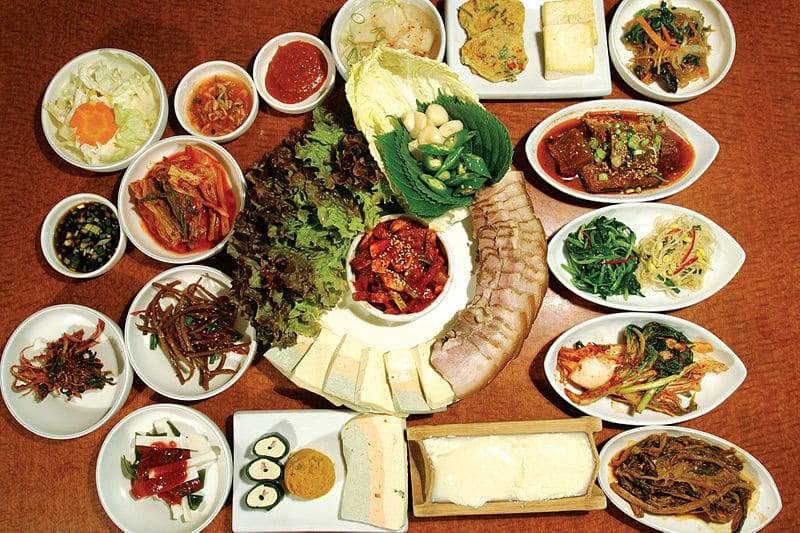 Bossam; Photo credit: Republic of Korea
Bossam; Photo credit: Republic of Korea
Bossam is made by boiling pork belly or pork neck in a broth mixed with garlic, ginger, and various herbs.Because it is a perfect match with kimchi, bossam is always cooked after Gimjang (김장), which is a traditional Korean event when kimchi is made in large quantities for the winter. Bossam is eaten by dipping it in ssamjang or salted shrimp and wrapping it in lettuce and perilla leaves.Bossam has long been a favorite Korean food, as evidenced by Bossam Alley, a street located in the center of Seoul that is full of bossam restaurants.
Korean Seafood Dishes
Since Korea faces the ocean on three sides, Koreans enjoy a wide variety of seafood. Koreans eat the highest amount of seafood per capita in the world. It is rare to find a table of food that does not include seafood because most Korean cooking methods—fermenting, boiling, grilling, seasoning, and pickling— usually involve seafood.
17. 해물파전 (Haemul Pajeon: Korean Seafood Pancake)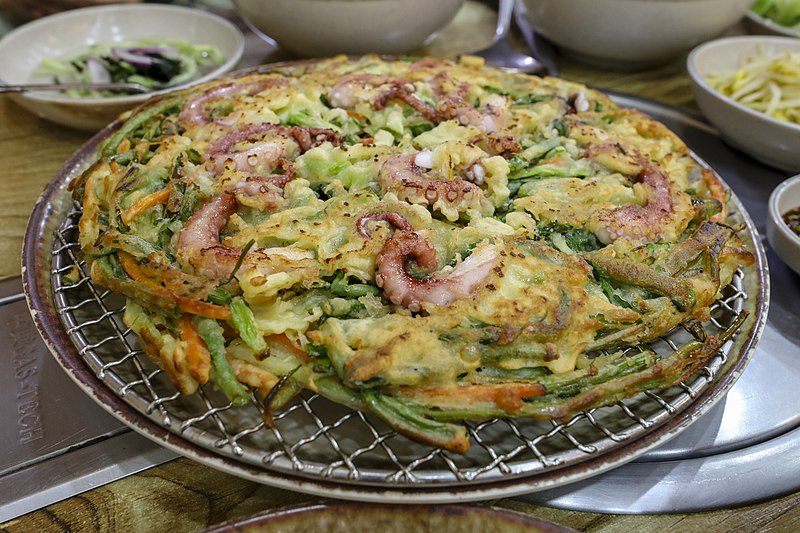
Haemul Pajeon is a Korean savory pancake made with green onions and seafood, including squid, and clams, and served with a vinegar soy sauce. The chewy texture of seafood and the crunchiness of green onions combine so the flavor comes through as you chew.People often eat haemul pajeon with Makgeolli (traditional rice wine) on rainy days. The sound of raindrops hitting a window or falling to the ground is similar to the sound of sizzling when you cook this savory pancake, which is why it is believed people want to eat haemul pajeon when they hear the sound of rain.
18. 고등어조림 (Godeungo Jorim: Braised Mackerel)
Godeungo Jorim is mackerel boiled in spicy seasoning. But even those who don’t particularly like the fishy odor and taste can enjoy the braised mackerel since the seasoning removes the smell. The recipe is very simple. Put sliced radish in a pot, place in the mackerel fillets, and put the seasoning mixed with red pepper powder, chopped green onions, and minced garlic on top. Then, just braise it for 15-20 minutes.
19. 간장게장 (Ganjang Gejang: Raw Crabs Marinated in Soy Sauce)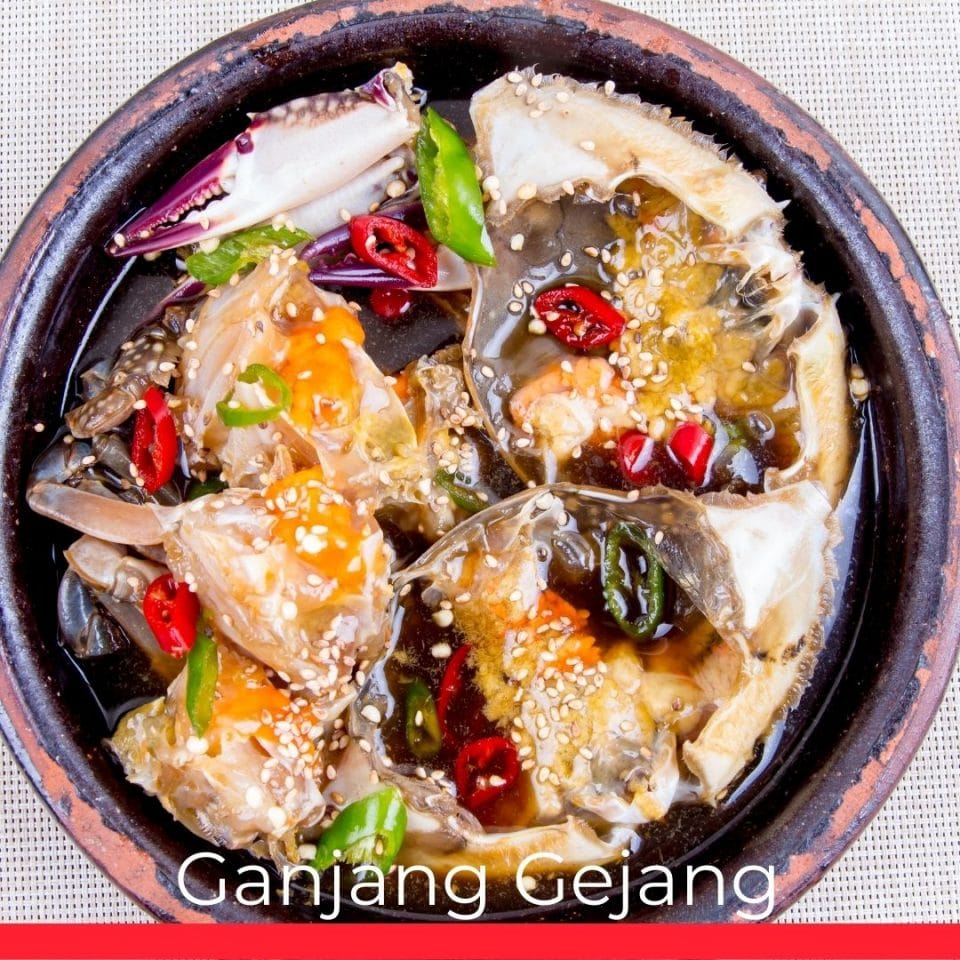
Ganjang Gejang is fresh raw crab marinated in soy sauce. Ganjang gejang is also known as ‘bap-dodook’ (밥도둑), which means rice thief. You will understand why it’s called rice thief when you finish your first bowl of rice in the blink of an eye. It’s just that good. However, some people are reluctant to eat this dish as they are not keen on eating raw crab. Ganjang gejang is one of the most contentious of Korean dishes.
If you would like to taste it, there is a recommended way to enjoy ganjang gejang. Put hot rice into the crab shell and mix it with dried seaweed and roe. This will wake up your taste buds.
20. 낙지볶음 (Nakji Bokkeum: Korean Spicy Stir-fried Octopus)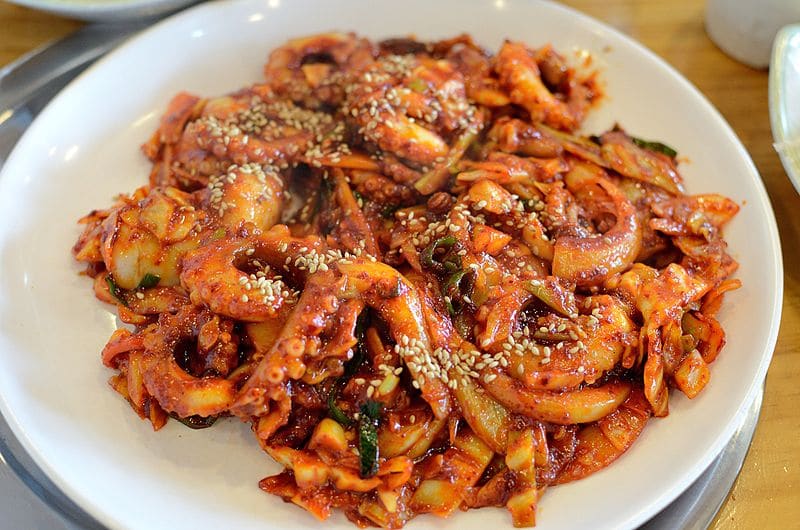
Nakji Bokkeum is stir-fried octopus in a spicy sauce. The most common way to eat stir-fried octopus is to mix it with rice. When you order nakji bokkeum in a restaurant, it is either brought to the table or cooked at the table, with rice served separately.
Even when mixed with rice, this stir-fried octopus is super crazy spicy at some restaurants. Usually, boiled bean sprouts are served alongside to reduce the spiciness. Some Koreans even say they are hooked on this tasty spicy dish!
Korean Street Food
Street vendors are easy to find in Korea. From a simple snack to an actual meal, there is always something for everyone. So profuse is it, Korea is sometimes called a street food paradise and is unquestionably one of the best destinations for street food in the world. In a recent survey, foreign tourists cited street food as their best experience in the country.
So, let’s take a look at some representative Korean street foods.
21. 호떡 (Hotteok: Korean Sweet Pancakes)
Hottoek is a Korean-styled pancake. One of the most popular Korean street snacks, it is made from a simple flour batter and filled with sweet syrup made from cinnamon, brown sugar, and peanuts. It’s a great snack when you’re between meals
It’s not difficult to find street vendors that sell hotteok in Korea. Hot off the grill, it is served folded in a paper cup or in thin cardboard. You need to be extra careful not to burn your tongue when the sweet hot filling seeps out as you bite into it.
22. 떡볶이 (Tteokbokki: Spicy Stir-fried Rice Cakes)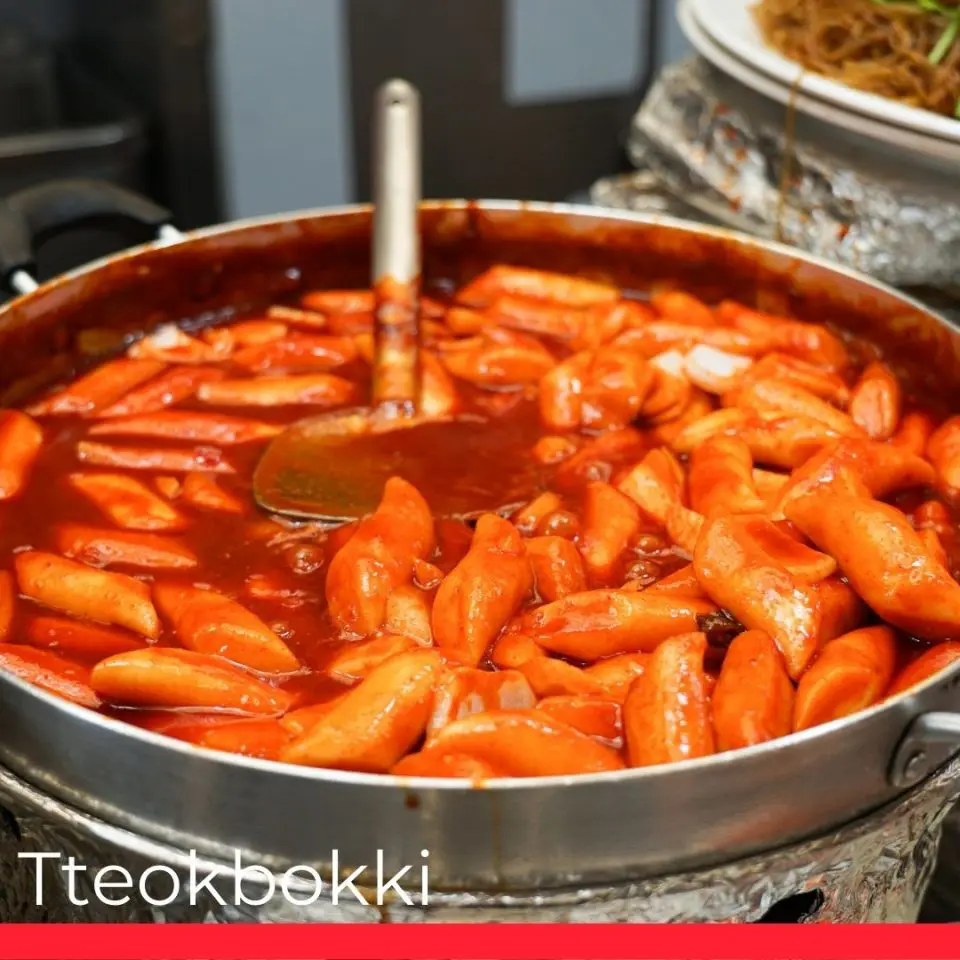
Tteokbokki is a food that is made by stir-frying rice cakes with other ingredients. It always ranks in the top 10 of Korean foods.There are many variations apart from regular tteokbokki: Rabokki with instant ramyeon noodles, Gukmul tteokbokki served with extra broth, Gireum tteokbokki made by stir-frying the rice cakes in oil, Ganjang tteokbokki with soy sauce, and Cheese tteokbokki served with melted cheese on top.
23. 순대 (Soondae: Korean Sausage)
Soondae is another Korean snack. Generally, pig intestines are stuffed with dangmyeon (transparent noodles), vegetables, and pig’s blood. It is a similar concept to sausage or blood sausage.The interesting thing is that the dipping sauce for soondae varies depending on the region in Korea you are eating it. In Seoul, Gyeonggi Province, it is served with salt. However, people in Gyeongsang Province, in places such as Busan and Ulsan, have soondae with Makjang or Ssamjang (a sauce made with doenjang and gochjang). Chojang (a spicy sweet red chilli pepper sauce) are the favored dipping sauces in places in Jeolla Province such as Gwangju Metropolitan City. But the people of Chungcheong Province prefer to dip soondae in a salted fermented shrimp sauce.
Korean Desserts
There are many traditional desserts made from rice in Korea. But today, there are also increasing numbers of fusion desserts that mix Korean recipes and ingredients with those of Western desserts. A typical example is a doughnut made with rice or glutinous rice flour rather than wheat.Here are two key Korean desserts.
24. 빙수 (Bingsu: Korean Milk Ice Sorbet)
Bingsu is a popular Korean ice dessert, originally made of ice shavings and sweetened red beans. If you ask Koreans what their favorite summer sweet is, a whole bunch of them will respond with bingsu.
The most popular sort of bingsu is Pat Bingsoo. Pat refers to the sweetened red beans that are added to the top of the milk flakes. However, there are other ways to enjoy bingsu. Gwahil bingsu comes with a fruit cocktail on top. There is even Greentea bingsu that is served topped with green tea ice cream.
25. 식혜 (Sikhye: Sweet Rice Punch)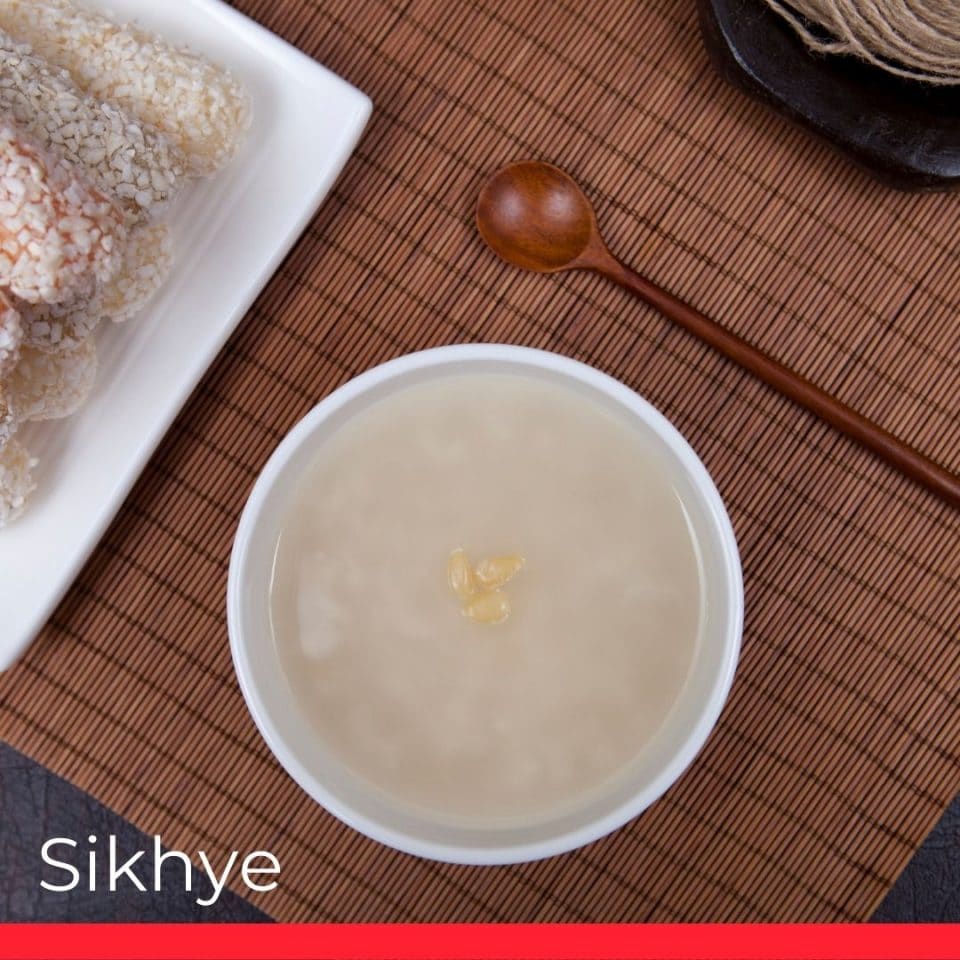
Sikhye is a traditional Korean beverage made with rice and malted barley powder. It is characterized by its cool, sweet, and slightly soft taste so it’s good to drink after meals.
Malted barley powder in Sikhye has a large number of enzymes that help the digestive system to work. This has made it popular on holidays and feast days after eating a lot of food.
Sikhye is usually served with pine nuts, which balance the nutrition and make it even more delicious.
Check out more popular Korean desserts in our ultimate list of the most popular 25 desserts and sweets in Korea.
Source: https://www.chefspencil.com








